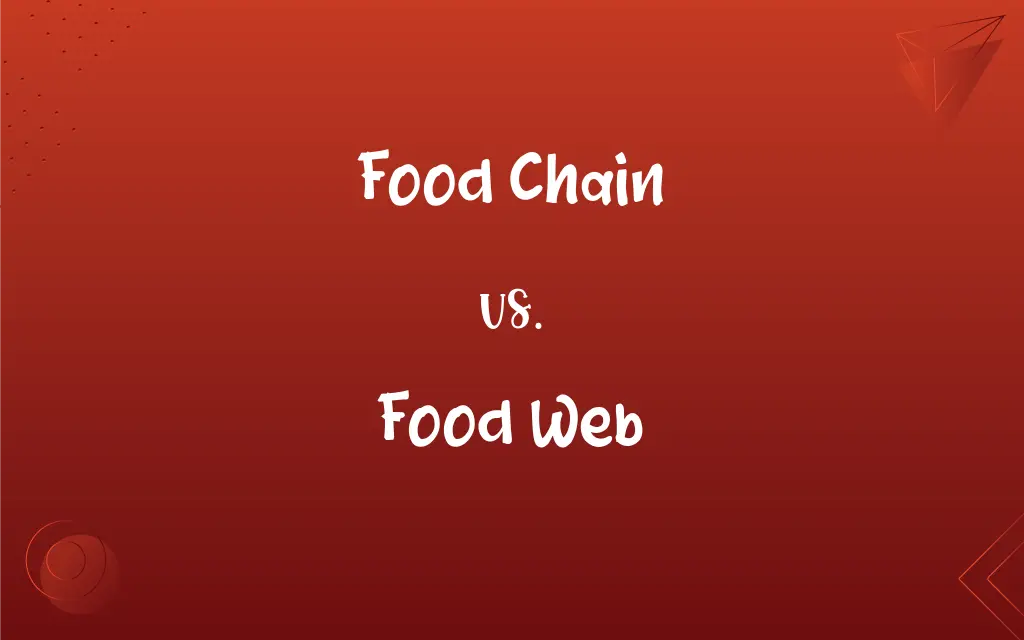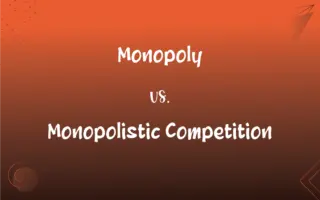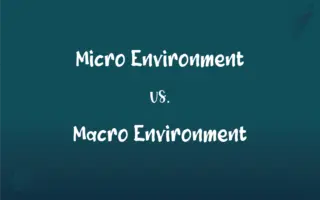Food Chain vs. Food Web: What's the Difference?
Edited by Aimie Carlson || By Harlon Moss || Updated on October 3, 2023
A food chain is a linear sequence of organisms through which nutrients and energy pass, while a food web consists of all interconnected food chains in an ecosystem, forming a network.

Key Differences
A food chain in an ecological community refers to a linear sequence whereby nutrients and energy move from one organism to another. It reflects a direct line of consumption, where one organism is eaten by another. Contrarily, a food web showcases a complex network of energy flow through interconnected food chains within an ecosystem. It maps multiple paths through which energy and nutrients pass, from plants through various levels of consumers and decomposers.
Predominantly, the food chain commences with primary producers, typically plants, that utilize sunlight to produce energy. These plants are subsequently consumed by herbivores, which are then consumed by carnivores, illustrating a straightforward passage of energy. However, the food web provides a holistic view, representing the myriad ways organisms feed off each other, incorporating numerous food chains to exhibit how they are interlinked, demonstrating nature’s complex feeding relationships.
The simplicity of a food chain can elucidate the direct relationships between predators and their prey. For instance, a grass-grain-chicken-human food chain is linear and self-explanatory. Conversely, the food web reflects a more inclusive and intersecting representation of relationships between different organisms, involving multiple prey-predator interactions and illustrating dependencies among different species, thereby highlighting an ecosystem’s stability and sustainability.
In essence, a food chain is a subset within the comprehensive food web. This distinction implies that while a food chain isolates and showcases one avenue of energy transfer amongst organisms, the food web encapsulates a multitude of such pathways, detailing varied interactions and providing a broader ecological picture. Therefore, a food web can better illuminate the redundancy and resilience within ecosystems, revealing how organisms have alternative food sources, creating a robust system.
Crucially, recognizing the differences between a food chain and a food web is pivotal for understanding ecological structures and interactions. The food chain simplifies understanding by detailing a linear path, offering clarity and ease in exploring ecological relationships. On the other hand, the food web reveals the complex and multifaceted relationships, cross-linking various food chains, thereby offering a thorough depiction of energy flow and species interactions within the ecological framework.
ADVERTISEMENT
Comparison Chart
Definition
A linear progression of energy flow through organisms.
A complex network of interconnected food chains within an ecosystem.
Complexity
Simple and straightforward.
Complex and intricate.
Number of Organisms
Involves a direct line of organisms.
Involves numerous organisms and their relationships.
Interconnectedness
Does not involve interconnected relationships.
Displays interconnected relationships among various organisms.
Reflects Ecosystem
Provides a narrow perspective of an ecosystem’s energy flow.
Provides a comprehensive view of energy flow in an ecosystem.
ADVERTISEMENT
Food Chain and Food Web Definitions
Food Chain
The food chain always begins with a primary producer that derives energy from non-living sources.
In the food chain, green plants are the initial link, converting sunlight into energy through photosynthesis.
Food Web
The food web depicts the various pathways through which energy is transmitted amongst organisms in an ecosystem.
A food web in the forest illustrates numerous interactions among plants, herbivores, and carnivores.
Food Chain
Food chains are uni-directional and illustrate the transfer of energy from one trophic level to the next.
The food chain highlights a direct energy pathway from plants through a series of consumers.
Food Web
A food web represents multiple interconnected food chains within an ecological community.
The complexity of the food web helps maintain the stability and biodiversity of the ecosystem.
Food Chain
A food chain demonstrates the linear pathway through which energy and matter flow in an ecosystem.
The simplest food chain in the ocean begins with algae and ends with the shark.
Food Web
Food webs map the varied diets of organisms, showcasing numerous feeding connections in the ecosystem.
In the marine food web, a single species might be a crucial source for multiple predators.
Food Chain
In a food chain, each organism feeds on the one before it and is eaten by the one after.
A common food chain in a grassland starts with grass and ends with a hawk.
Food Web
Through a food web, organisms are generally part of several food chains, portraying complex feeding relations.
Within the rainforest food web, the jaguar might prey on multiple species, like deer and monkeys.
Food Chain
Each step in a food chain is known as a trophic level, moving from producers to primary consumers and onwards.
The snake sits higher on the food chain than the mouse due to its predatory nature.
Food Web
A food web exhibits the myriad nutritional relationships and demonstrates ecosystem robustness and redundancy.
The food web reflects how ecosystems accommodate the loss of species through alternative feeding pathways.
FAQs
What is a food chain?
A food chain is a linear sequence of organisms in which each organism is eaten by the next, demonstrating energy flow.
Can an organism be part of multiple food chains?
Yes, in a food web, an organism often participates in several food chains, indicating varied feeding relationships.
How do decomposers fit into food chains and webs?
Decomposers break down dead organisms, recycling nutrients back into the ecosystem, crucial in both food chains and webs.
Why is the food chain considered simpler than the food web?
The food chain illustrates a singular, linear path of energy transfer, while the food web displays numerous interconnected paths.
How does energy efficiency vary between trophic levels in a food chain?
Typically, about 10% of energy is transferred to the next trophic level in a food chain due to metabolic and heat losses.
How does a food web differ from a food chain?
A food web comprises multiple interconnected food chains, showcasing a network of feeding relationships within an ecosystem.
What role do plants play in a food chain and web?
Plants, or primary producers, form the base, providing energy by converting sunlight via photosynthesis in both food chains and webs.
How do food chains and food webs help in studying ecological balance?
They facilitate understanding energy flow and organismal interactions, enabling insights into ecosystem stability, resilience, and health.
How does energy move in a food chain?
Energy moves linearly in a food chain, transferring from one organism to the next in a singular path.
Is it possible for a food chain to exist independently without being part of a food web?
Practically, all food chains interlink with others, forming a food web, even though they can be isolated for study.
What is the importance of a food web in an ecosystem?
A food web underscores the complexity, stability, and interdependence of organisms within an ecosystem, showing numerous feeding relationships.
Can changes in environmental factors impact food chains and webs?
Yes, alterations like temperature shifts or nutrient availability can modify organism populations, affecting both food chains and webs.
How many trophic levels are usually present in a food chain?
Food chains typically contain 3-5 trophic levels, moving from primary producers to top predators.
How does a change in primary producer population affect a food web?
A change at this base level reverberates throughout the food web, affecting all organisms within multiple food chains.
How are humans represented in food chains and webs?
Humans are typically top predators and are part of multiple food chains, prominently displayed in food webs.
What impact does the removal of a species have on a food web versus a food chain?
In a food web, alternative pathways often mitigate impacts, whereas in a food chain, the effect is usually direct and pronounced.
What is the role of apex predators in food webs?
Apex predators regulate species below them in food webs, maintaining balance and biodiversity in ecosystems.
How do food chains and webs illustrate biodiversity?
Food chains show simple predator-prey interactions, while food webs provide a holistic view of ecosystem biodiversity through varied feeding relationships.
Can food webs exist without primary producers?
No, primary producers (like plants) form the base of food webs, providing energy essential for all subsequent trophic levels.
Why are food webs considered more realistic representations of ecosystems?
Food webs encapsulate the multifaceted feeding relationships amongst organisms, reflecting the ecosystem’s actual complexity.
About Author
Written by
Harlon MossHarlon is a seasoned quality moderator and accomplished content writer for Difference Wiki. An alumnus of the prestigious University of California, he earned his degree in Computer Science. Leveraging his academic background, Harlon brings a meticulous and informed perspective to his work, ensuring content accuracy and excellence.
Edited by
Aimie CarlsonAimie Carlson, holding a master's degree in English literature, is a fervent English language enthusiast. She lends her writing talents to Difference Wiki, a prominent website that specializes in comparisons, offering readers insightful analyses that both captivate and inform.































































